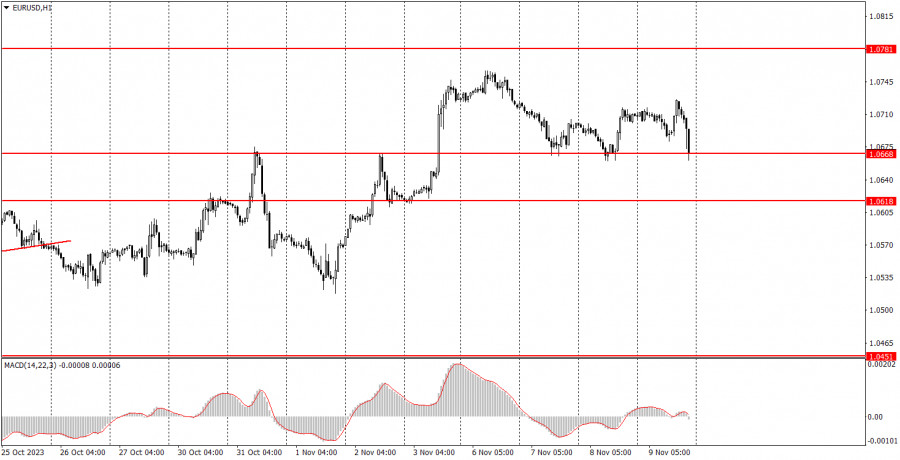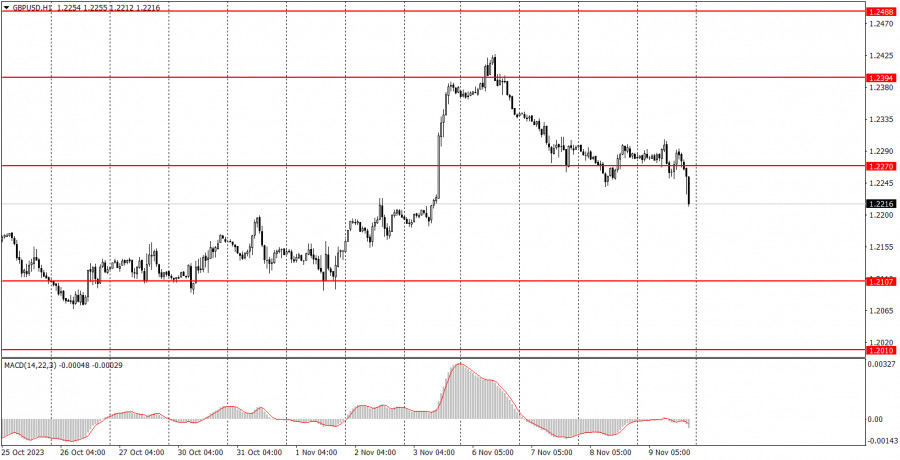

There are several macroeconomic events on Friday, with the most important ones in the United Kingdom. Namely the reports on quarterly GDP and industrial output for September. The industrial production report is not crucial, but in the case of a significant deviation of the actual value from the forecast, market reaction is possible. The same goes for the GDP report. If its value matches the forecast, no reaction is expected, despite the importance of this report. In the United States, the University of Michigan's consumer sentiment index will be published, which is also a secondary report.
Analysis of fundamental events:From Friday's fundamental events, we can highlight the speeches by representatives of the Federal Reserve's monetary committee, Logan and Bostic. However, Fed Chair Jerome Powell has already spoken twice this week. If his first speech did not touch on monetary policy, in the second one, he noted that the key rate may rise again if the situation requires it. Therefore, we probably won't hear anything that is more important than these statements.

On Friday, there will be interesting events, but in general, they may not lead to significant price movements. On Thursday, Powell's speech supported the dollar, but the US currency should continue to rise in the coming weeks even without the help of the Fed chairman. On Friday, only the British reports have a real chance of influencing the movement of the GBP/USD pair. And the pound may pull the euro along with it. But this will only happen during the European session.
Basic rules of a trading system:1) Signal strength is determined by the time taken for its formation (either a bounce or level breach). A shorter formation time indicates a stronger signal.
2) If two or more trades around a certain level are initiated based on false signals, subsequent signals from that level should be disregarded.
3) In a flat market, any currency pair can produce multiple false signals or none at all. In any case, the flat trend is not the best condition for trading.
4) Trading activities are confined between the onset of the European session and mid-way through the U.S. session, post which all open trades should be manually closed.
5) On the 30-minute timeframe, trades based on MACD signals are only advisable amidst substantial volatility and an established trend, confirmed either by a trend line or trend channel.
6) If two levels lie closely together (ranging from 5 to 15 pips apart), they should be considered as a support or resistance zone.
How to read charts:Support and Resistance price levels can serve as targets when buying or selling. You can place Take Profit levels near them.
Red lines represent channels or trend lines, depicting the current market trend and indicating the preferable trading direction.
The MACD(14,22,3) indicator, encompassing both the histogram and signal line, acts as an auxiliary tool and can also be used as a signal source.
Significant speeches and reports (always noted in the news calendar) can profoundly influence the price dynamics. Hence, trading during their release calls for heightened caution. It may be reasonable to exit the market to prevent abrupt price reversals against the prevailing trend.
Beginning traders should always remember that not every trade will yield profit. Establishing a clear strategy coupled with sound money management is the cornerstone of sustained trading success.